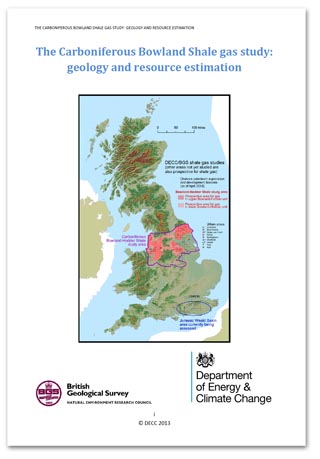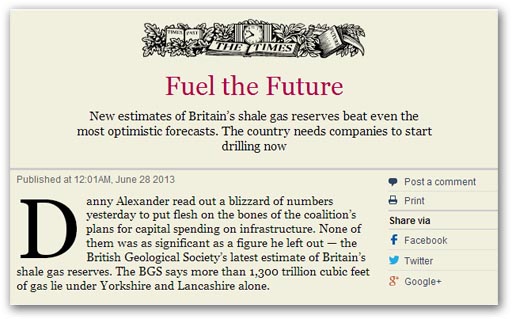Media: technical illiteracy
Friday 28 June 2013
First, there was the "cuts" story where there simply is no reduction in public spending; then there was the supposed "cave-in" by the European Parliament over the EU budget, which turns out to be quite the reverse – a surrender by member state governments. And then there are the energy stories, the one strand telling us of imminent power cuts and the other parading our shale gas "reserves". On this latter context, we see The Times editorial (paywall - extract above) happily chirping about the "British Geological Society's latest estimate of Britain’s shale gas reserves". Notwithstanding that Danny Alexander did mention the "1,300 trillion cubic feet" figure, the point is that the BGS did not make any estimates of potential reserves. In fact, as it has gone to some lengths to explain in its report, it has studiously avoided making any estimates (see para 2.2. Resources vs. reserves). In simple terms, the BGS says, the resource estimate for any shale gas play is the amount of gas in the ground (some of which might never be produced), while the reserve estimate is a more speculative measure which describes the amount of gas that you might be able to extract given appropriate technology, economics and other factors. And because of the common confusion in the media between the terms, "resource" and "reserve", the Parliamentary Office for Science and Technology recently issued a briefing note on "Resource and Reserve Terminology", making clear the difference. Needless to say, all this passes-by the mighty "Thunderer", a newspaper that once claimed to be the paper of record. Scholars still to this day refer to its archives as a reliable record or what might have transpired. Its technical illiteracy is shared by Sky News, by Channel 4 News, but just to prove it can be done, the Financial Times gets it right, unlike the august Wall Street Journal, which manages to confuse itself as well as its readers. In this case, the distinction The Times fails to make demonstrates that its journalists have not read the original report – had they done so, they could not have missed the warnings. And the distinction is much, much more than academic pedantry. Depending on the precise conditions under the ground, the recovery factor (the percentage of the resource that can be commercially recovered) can range from about 15 percent to zero. Until very recently, when the technology had improved, the recovery factor has been zero. And until there can be some estimates as to the reserves, based on further exploration, trial drilling and technology development and proving, there is going to be no significant commercial exploitation of the resource. This might take some years. Thus, for The Times airily to proclaim that, "the country needs companies to start drilling now" is both premature and superficial. This is "man-in-pub" commentary. If its readers want better, they have to go elsewhere. COMMENT THREAD Richard North 28/06/2013 |
Energy: not so good and not so bad news
Friday 28 June 2013
 It was never going to be the case that the media was going to plough through a 64-pagetechnical report on shale gas reserves, produced by the British Geological Survey (BGS). Nor were the media ever going to reproduce the cautious phrasing of the report, and convey the news with all the scientific caveats. It was never going to be the case that the media was going to plough through a 64-pagetechnical report on shale gas reserves, produced by the British Geological Survey (BGS). Nor were the media ever going to reproduce the cautious phrasing of the report, and convey the news with all the scientific caveats.Thus, we have good news, conveyed byReuters and others, which tells us that the Bowland-Hodder shale holds 1,300 trillion cubic feet (tcf) of gas. This latest estimate indicates shale gas, says the agency, could transform the UK energy market, even though typically only 10 to 15 percent of shale gas in place is recoverable. It compares with British consumption of 2.76 trillion cubic feet last year, giving us potentially 60 years of supply, at current consumption rates. This compares with recent estimatessuggesting that there could be as much as 500 tcf in the Bowland shale across the North West. The actual range for the entire deposit stands between a low estimate of 882 tcf, 1,329 tcf for the mid-level estimates, and 2,281 tcf at the high end. Potentially, we could have 100 years-worth of supply. However, the cautious tenor of the report brings us down to earth, with BGS refusing to estimate extraction rate, saying that a "bottom-up" resource assessment of gas in-place has be made, which more accurately reflects the area's shale gas potential. The large volume of gas has been identified in the shales beneath central Britain, but not enough, says BGS, is yet known to estimate a recovery factor, nor to estimate potential reserves (how much gas may be ultimately produced). Thus, beyond a very early estimate of 4.7 tcf yield, the Survey is prepared to go no further. Thus, this news is good but not yet as good as it could be. But it is at least good news, compared with Ofgem's "Electricity Capacity Assessment Report 2013", also published yesterday - the second such report Ofgem has produced. But again it was never going to be the case that the media was going to plough through the full report, this one being 122 pages long and largely devoid of media-friendly language.  This, however, has not stopped reporterstelling us that the "risk of UK blackouts has tripled in a year", as well as us "facing an energy crunch that will push up bills". TheDaily Mail goes even further, telling us of "power cuts in two years" and that electricity [is] "to be rationed", with a front-page banner headline breaking the news. This, however, has not stopped reporterstelling us that the "risk of UK blackouts has tripled in a year", as well as us "facing an energy crunch that will push up bills". TheDaily Mail goes even further, telling us of "power cuts in two years" and that electricity [is] "to be rationed", with a front-page banner headline breaking the news.Looking at the detail of the report, though, we see that the projections are based on computer modelling, offering a range of scenarios. These illustrate the impact of "projected demand reductions not materialising", and the effect of "high demand sensitivity that uses National Grid's broadly flat demand projection from last year". We also get a "low supply sensitivity" scenario, with "pessimistic assumptions on the supply side". On the basis of an assumption that there is higher than expected demand, and factors interfere with price mechanisms that pull more capacity into the market, there is a possibility that the "expected volume of demand that may not be met because of electricity shortfalls". Even that is not as bad as it sounds, though. Controlled disconnections of customers - involving industrial and commercial sites before households - would only take place, says Ofgem, if a large deficit were to occur. This, we are told, is because the System Operator is usually able to manage supply shortfalls up to a certain level with little or no impact on customers, such as by making use of emergency interconnector services that involve increasing imports, and reducing exports where possible. Thus, while there is indeed a possibility of power cuts, the pessimistic assumptions attendant on the modelling make these a worst-case scenario for the moment. And, given that shale gas may be coming on line, which may create incentives for building new gas plant, the situation might not be anything like as as bad as is painted. In short, we have some not so good and some not so bad news. But that wasn't good enough for our legacy media, so we were treated to unqualified projections. Fortunately – in the age of the internet – we can see the original reports, and make up our own minds on whether to read the facts or the spin. COMMENT THREAD Richard North 28/06/2013 |
Friday, 28 June 2013
Posted by
Britannia Radio
at
21:37
![]()






















